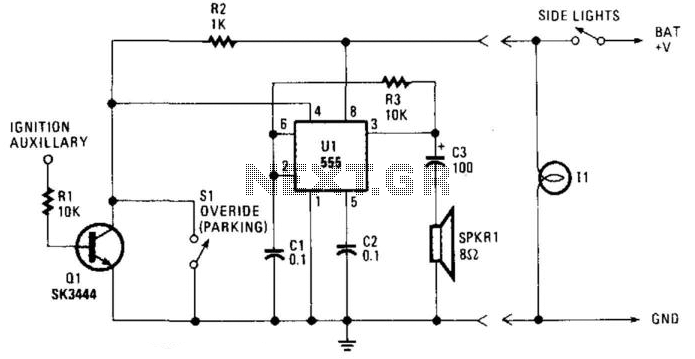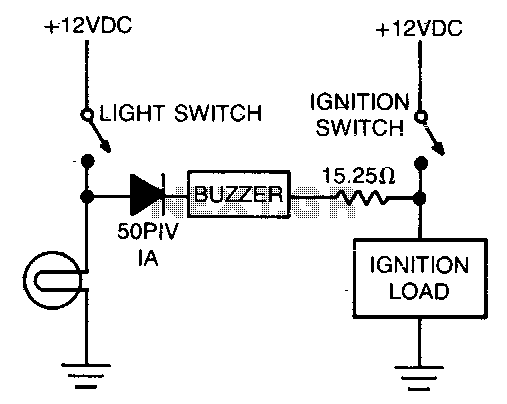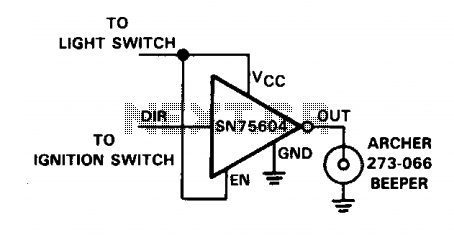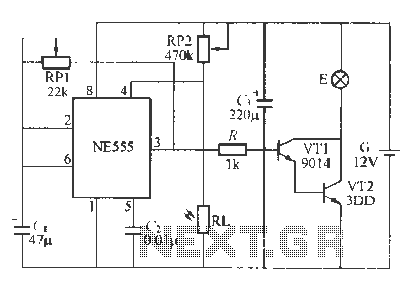
Lights-On Warning

The circuit derives its power from the car's side lights, preventing oscillation unless the lights are on. The reset pin on the 555 timer connects to transistor Q1. The base of Q1 is linked through resistor R1 to the ignition auxiliary terminal in the car's fuse box. When the ignition is activated, power is supplied to the base of Q1, turning it on. With Q1 activated, pin 4 of U1 is pulled low, disabling the oscillator and silencing the alarm. If the ignition is turned off while the lights remain on, power is supplied to the 555 timer, causing Q1 to turn off, which triggers the alarm. Switch S1 serves as an optional override.
The circuit operates using a 555 timer configured in monostable mode, where the timer generates a single output pulse in response to a trigger. The power source is derived from the vehicle's side lights, which ensures that the circuit remains inactive when the lights are off, thereby conserving battery power and preventing unnecessary alarm activation. The 555 timer's reset pin is crucial for controlling the timer's operation; it is connected to the emitter of transistor Q1, which acts as a switch.
When the ignition is turned on, the auxiliary terminal supplies voltage to the base of Q1 through resistor R1. This base current allows Q1 to enter saturation, effectively grounding pin 4 of the 555 timer. In this state, the timer's output remains low, and the alarm is disabled. The use of a resistor to limit the base current is essential for protecting the transistor from excessive current, which could lead to component failure.
If the ignition is turned off while the side lights are still illuminated, the power continues to flow to the 555 timer, as it is connected to the side lights. This condition results in Q1 turning off, releasing the reset pin of the timer and allowing it to oscillate. The output from the timer then activates the alarm, alerting the user.
The optional switch S1 provides a manual override feature, allowing the user to bypass the automatic control of the alarm system. This can be useful in situations where the alarm needs to be silenced without turning off the ignition or lights. The design ensures that the alarm system is both responsive and user-friendly, offering flexibility in operation while maintaining safety and efficiency in the vehicle's electrical system. Because power for the circuit is obtained from the car"s side lights, the circuit can"t oscillate unless the lights are o n. The reset pin on the 555 connects to transistor Ql. The base of Ql is connected through R1 to the ignition auxiliary terminal on the car"s fuse box. When the ignition is turned on, power is supplied to the base of Ql, which turns it on. With Ql turned on, pin 4 of Ul is tied low, which disables the oscillator and inhibits the alarm. If the ignition is turned off while the lights are on, power is applied to the 555 and Ql is turned off, and the alarm starts. Switch Si is an optional override.
The circuit operates using a 555 timer configured in monostable mode, where the timer generates a single output pulse in response to a trigger. The power source is derived from the vehicle's side lights, which ensures that the circuit remains inactive when the lights are off, thereby conserving battery power and preventing unnecessary alarm activation. The 555 timer's reset pin is crucial for controlling the timer's operation; it is connected to the emitter of transistor Q1, which acts as a switch.
When the ignition is turned on, the auxiliary terminal supplies voltage to the base of Q1 through resistor R1. This base current allows Q1 to enter saturation, effectively grounding pin 4 of the 555 timer. In this state, the timer's output remains low, and the alarm is disabled. The use of a resistor to limit the base current is essential for protecting the transistor from excessive current, which could lead to component failure.
If the ignition is turned off while the side lights are still illuminated, the power continues to flow to the 555 timer, as it is connected to the side lights. This condition results in Q1 turning off, releasing the reset pin of the timer and allowing it to oscillate. The output from the timer then activates the alarm, alerting the user.
The optional switch S1 provides a manual override feature, allowing the user to bypass the automatic control of the alarm system. This can be useful in situations where the alarm needs to be silenced without turning off the ignition or lights. The design ensures that the alarm system is both responsive and user-friendly, offering flexibility in operation while maintaining safety and efficiency in the vehicle's electrical system. Because power for the circuit is obtained from the car"s side lights, the circuit can"t oscillate unless the lights are o n. The reset pin on the 555 connects to transistor Ql. The base of Ql is connected through R1 to the ignition auxiliary terminal on the car"s fuse box. When the ignition is turned on, power is supplied to the base of Ql, which turns it on. With Ql turned on, pin 4 of Ul is tied low, which disables the oscillator and inhibits the alarm. If the ignition is turned off while the lights are on, power is applied to the 555 and Ql is turned off, and the alarm starts. Switch Si is an optional override.





